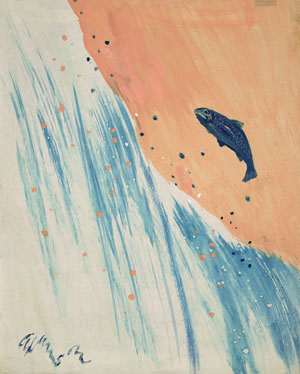
IT IS high season in the garden, just past summer solstice. The land is heavy with crops while the bloodline of Redwood Creek, where I have lived, gardened, and meditated for over three decades, runs through the old-growth redwoods at Muir Woods National Monument out to the sea. Redwood Creek is a short, seven mile-long spawning stream for silver salmon, ancient members of the endangered Coho salmon line. In January of 2008, Muir Woods commemorated its centennial year. The month also marked the first time in its recorded history when not a single silver salmon returned to spawn in our watershed.
The reasons for salmon collapse are brutally clear: global climate change has caused the oceans to warm, suppressing the timely upwelling of nutrients needed to sustain young salmon at sea. Ocean pollution has spiked. Maritime overfishing is at record heights, and salmon genetics have been weakened by hatchery programs that interbreed wild lines of salmon with farmed fish stock.
My grief over, and response to, salmon collapse in our watershed is both personal and communal. The Nature Conservancy recently designated Redwood Creek watershed as one of twenty-five biodiversity “hot spots” targeted by the global conservation community as key to preserving the world’s ecosystems. For half of my life, I have timed work and winter meditation practice to the spawning cycle of silver salmon in our home watershed, marking when to begin winter pruning and the restoration planting of native conifers on the coastal headlands by the return of salmon to Redwood Creek.
The migratory pattern for salmon follows a counterclockwise gyre in the great pastures of the north Pacific Ocean. After two years in the ocean, salmon return home to their exact natal streams to spawn and die. These primordial fish are believed to navigate with the aid of an inner magnetic map that enables them to know approximately where they are in relationship to their home watershed at all times.
In early February, we organize an annual all-day watershed walk that begins at Redwood Creek and ends eight miles later at Green Gulch Farm.
On this walk a few years ago, a fallen red alder tree blocked our passage across a narrow footbridge spanning a remote section of Redwood Creek. We dropped down a steep muddy bank to ford the creek. It was a cold winter morning with a rime of ice at the frozen edge of the water. Just upstream from our ford, two huge tattered salmon were suspended in the icy creek above a rocky bed of gravel where the female fish had excavated her redd, or spawning nest.
We stood together in silence for half an hour as the silver salmon swam in tandem, timing their ancient movements to each other. The larger red-backed male quivered as he neared the female, holding his position in the swift water by unhinging his hooked mouth and using the gape of his jaw to steady his place in the creek. His partner swam just below him, crouching above her gravel redd as he hovered nearby. I saw that the scaly flesh of her finned tail was battered raw and broken open from digging out her rocky nest. We left before the pair spawned, suddenly shy and disoriented in their primitive spell.
It has been six months since the announced salmon collapse in our home watershed. We continue to farm more fiercely than ever, growing food and practicing meditation every day. Often I think of the words of my friend and mentor, former commercial salmon fisherman and watershed activist Freeman House: “In one ancient language the word memory derives from a word meaning mindful, and in another from a word to describe a witness, and in yet another it means, at root, to grieve. To witness mindfully is to grieve for what has been lost.” Standing above the summer river as it moves in slow loops of languid water, I watch the green shadows below flicker with old silver fire.
Thank you for subscribing to Tricycle! As a nonprofit, we depend on readers like you to keep Buddhist teachings and practices widely available.